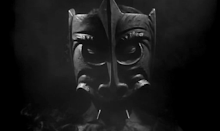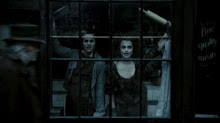
We bring a lot to the movies we watch. It’s no secret that personal experience affects how we watch a movie, it’d be odd if it didn’t. Does Broadcast News have more significance for me then someone else because I lived out the Albert Brooks leg of that particular love triangle? Does Dogma intrigue me more then most because I share Smith’s Catholic School education, fascination with the possibility of the divine, and engrained smart ass streak? Does The Royal Tenenbaums hit just so because I see so much of myself and my family reflected in it? The answer to each is Undoubtedly.
But every so often a kind of reverse osmosis happens and a movie insinuates itself into your life and being. I’m not talking about the dazed, narcotic, happiness that comes from the first viewing of a movie that you know will become a favorite or one that articulates something within yourself. I don’t know if I can even quite put it into words. All I know is that watching Donnie Darko is more like taking a bite out of one of Proust’s Madeline’s then watching a movie. I watch it not alone but with my sixteen year old self sitting on the couch next to me brought back vividly to life.

The detractor’s of Donnie Darko, mostly those who caught it on its second wave of buzz, usually condemn the movie as an ungainly, awkward, overblown mess. To a certain extent I would agree, yet at the same time I’d argue that there are probably no three words that better describe adolescence, and any movie that deals with that subject, and is not a little ungainly with its sincerity, awkward with its ambitions, and overblown in its emotions is doing something seriously wrong.
I will concede that the film’s success did have a lot to do with its timing. Many have remarked about the reverse serendipity that had a film about a mysterious plane crash come out a mere month after 9/11. But it wasn’t so much the specifics of 9/11 that Darko seemed to so eerily and completely capture as the feeling of dislocation it brought.
It happened to come out at a moment when a bunch of scared teenagers had just watched the world fall about around them and found in Donnie an able surrogate. True no giant Bunny Rabbits showed up on the golf course to tell us the world was about to end. But to a suburban kid who had been taught all his life to believe in American invincibility and watched that lie implode in on itself on September 11th, The Lone Bunny Of The Apocalypse would hardly be more of a deviation from the norm.
But in all honesty, it’s not the apocalyptic overtones, monologues about Smurf sex, “Grandma Death” narrative puzzles, Donnie’s scenes of “stick it to the man grandstanding”, Kelly’s striking Wunderkid imagery, or any of the other things that so deeply impressed me at sixteen, that really resonate with me now.



Because that’s what makes Donnie Darko so special. What has allowed it to still resonate ten years on, now that the novelty of its strangeness has worn off and to keep its reputation intact despite the sayers of neigh. At it’s core beneath all the brainteasers, mythology and games, it remains a simple human story (The fact that Kelly’s next film was nothing but brainteasers, mythology and games sans human story goes a long way to explaining that film’s ultimately doesn't work) one of a young man trying to survive in a baffling, occasionally hostile universe, while maintaining some measure of happiness and grace. Now I don’t know about you, but that still pretty well describes my day to day life.
And that’s why though I always watch Donnie Darko with my sixteen year old self next to me on the couch, it never feels like a simple piece of nostalgia to be tucked safely away in the past. Like all the movies that become part of our life it provides a continuity between who I was and who I am, and where those two things overlap.
















































































































 This would seem the natural end point for the sequence. After all it mirrors the opening shot, it would bring everything back the perspective of the audience. But no. One last time, there must be a cut, Powell must remind us that Film and Theater are not the same.
This would seem the natural end point for the sequence. After all it mirrors the opening shot, it would bring everything back the perspective of the audience. But no. One last time, there must be a cut, Powell must remind us that Film and Theater are not the same.





































































































